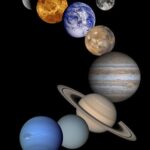Though we are able to view wonderful colors of the nature through our eye, human eye is sensitive to only a very narrow fraction of whole electromagnetic spectrum of light. Light wave is basically a radiation emitted when matter interact electromagnetically and depending upon the nature of interaction, different kind of light will have different frequency and wavelength. In nature, there is another commonly observed interaction we know of for centuries – gravitational interaction, which is responsible to keep planets going around the sun. Albert Einstein, through his theory of general relativity, predicted that gravitational interaction is not only responsible for making planets keep going around the sun but also leads to the production of wave which we call gravitational wave. Gravitational wave, sensitive enough for detection, is rather produced in violent type of gravitational interaction between massive objects like stars and galaxies. One of such interactions occurs when two massive stars in close proximity to each other are pulled towards each other and undergo violent interaction during their final days of life. As the two stars spiral each other around a common center of mass they start to loose energy in the form of gravitational wave (GW).

This is one type of gravitational interaction that creates a wave of particular frequency and observable from LIGO type gravitational wave detector. In this article, we talk about a gravitational wave of different frequency. Most of the galaxies are believed to have a very massive black hole in its center. When two galaxies interact these two black holes in the galactic center interact gravitationally and start to interact with each other around a common center of mass. We call them super massive binary black holes(SMBBH). Our Milky-way galaxy at some point in future will also undergo similar interaction with Andromeda galaxy. Gravitational wave produced due to such interaction will have characteristic frequency that is not detectable by LIGO. If we could tune into one of such SMBBH it would be producing continuous wave and hence be observable in certain frequency. However, in the universe, there are many of such SMBBHs and the GWs emitted by larger number of SMBBHs will interfere with each other and such GW is stochastic in nature producing frequency at nano-hertz scale. Any earth based instrument won’t be able to detect them. So, how do scientist detect them?
Stars in the sky can come to our rescue. A very unique type of star called millisecond pulsar(MSP) which emits light at very precise time due to its immensely accurate period of rotation is employed for this purpose. There are many of them scattered all over the sky. Over the course of years, many of them have been carefully studied and their time period measured with extreme degree of accuracy. As a result of which, we know when the light from these stars should hit telescopes in the earth. If the space-time is not distorted due to any kind of disturbances this time of arrival of light will be accurate without any delay and in the time series data observed we see signal at exactly same instant of time we expect. However, if gravitational waves is passing through the space time, where these milli-second pulsars are, the distortion caused in the space-time due to such GWs will cause delay in the arrival time for light coming from these stars to the earth.

By measuring this delay in arrival time of wave signal from many such pulsars in the sky we confirm the existence of stochastic gravitational wave background. If there is a GW passing by it will slightly distort the space-time around the earth and hence the time of arrival will differ from regular time of arrival when there is no any GW passing through earth. This tiny vibration in the space time position of the earth caused to many supermassive black hole merger interaction can hence be observed. While we still have a long way to go to fully understand such gravitational wave signatures caused due to different types of gravitational interaction, last year, scientists published a paper and did a press release informing that they believe they have credible evidence that such vibrations in the universe can be observed and studied.







